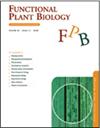Relative contribution of photorespiration and antioxidative mechanisms in Caragana korshinskii under drought conditions across the Loess Plateau.
IF 2.6
4区 生物学
Q2 PLANT SCIENCES
引用次数: 11
Abstract
The drought-tolerant plant Caragana korshinskii Kom. was used to investigate the relative contribution of photorespiration and antioxidative mechanisms to water-stress adaptations across the Loess Plateau. The samples were collected from Shenmu, Yulin and Dongsheng along with the reduction of rainfall. The results showed the lower leaf water potential and the lower content of O2•- and malondialdehyde (MDA) were found in the plants in drier zone. H2O2 didn't show a significant difference among these sampling sites. Both photorespiratory rate (PR) and net photosynthetic rate (PN) increased with the decrease of rainfall. Low rainfall upregulated the gene expression and activities of photorespiratory enzymes. In addition, ascorbate peroxidase (APX), glutathione peroxidase (GPX) and superoxide dismutase (SOD) activity and reduced glutathione (GSH), ascorbic acid (AsA) contents increased with the decrease of rainfall, whereas catalase (CAT) activity decreased. These results indicate photorespiration could play a protective role for the photosynthetic apparatus from photoinhibition and photodamage under low rainfall levels, which could also act together with the antioxidation system to improve the tolerance to drought in C. korshinskii.黄土高原干旱条件下柠条光呼吸和抗氧化机制的相对贡献
耐旱植物锦鸡儿。研究了光呼吸和抗氧化机制对黄土高原水分胁迫适应的相对贡献。随着降雨的减少,在神木、榆林和东胜采集了样品。结果表明,干旱地区植物叶片水势较低,O2•-和丙二醛(MDA)含量较低;各采样点间H2O2含量差异不显著。光呼吸速率(PR)和净光合速率(PN)随降雨量的减少而增加。低降雨量上调了光呼吸酶的基因表达和活性。抗坏血酸过氧化物酶(APX)、谷胱甘肽过氧化物酶(GPX)、超氧化物歧化酶(SOD)活性及还原性谷胱甘肽(GSH)、抗坏血酸(AsA)含量随降雨量的减少而升高,过氧化氢酶(CAT)活性则降低。这些结果表明,光呼吸在低降雨条件下可以保护光合器官免受光抑制和光损伤,并与抗氧化系统共同作用,提高柠条的抗旱性。
本文章由计算机程序翻译,如有差异,请以英文原文为准。
求助全文
约1分钟内获得全文
求助全文
来源期刊

Functional Plant Biology
生物-植物科学
CiteScore
5.50
自引率
3.30%
发文量
156
审稿时长
1 months
期刊介绍:
Functional Plant Biology (formerly known as Australian Journal of Plant Physiology) publishes papers of a broad interest that advance our knowledge on mechanisms by which plants operate and interact with environment. Of specific interest are mechanisms and signal transduction pathways by which plants adapt to extreme environmental conditions such as high and low temperatures, drought, flooding, salinity, pathogens, and other major abiotic and biotic stress factors. FPB also encourages papers on emerging concepts and new tools in plant biology, and studies on the following functional areas encompassing work from the molecular through whole plant to community scale. FPB does not publish merely phenomenological observations or findings of merely applied significance.
Functional Plant Biology is published with the endorsement of the Commonwealth Scientific and Industrial Research Organisation (CSIRO) and the Australian Academy of Science.
Functional Plant Biology is published in affiliation with the Federation of European Societies of Plant Biology and in Australia, is associated with the Australian Society of Plant Scientists and the New Zealand Society of Plant Biologists.
 求助内容:
求助内容: 应助结果提醒方式:
应助结果提醒方式:


